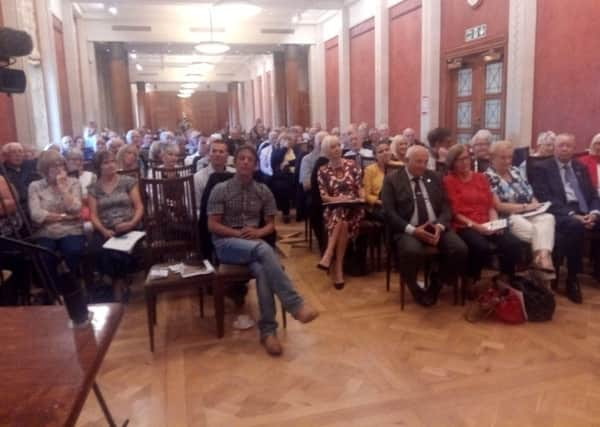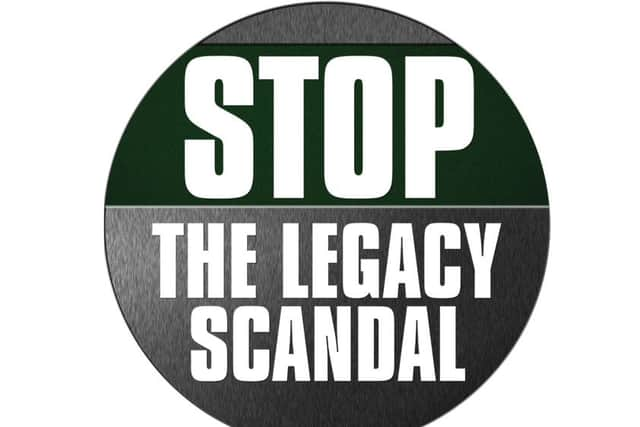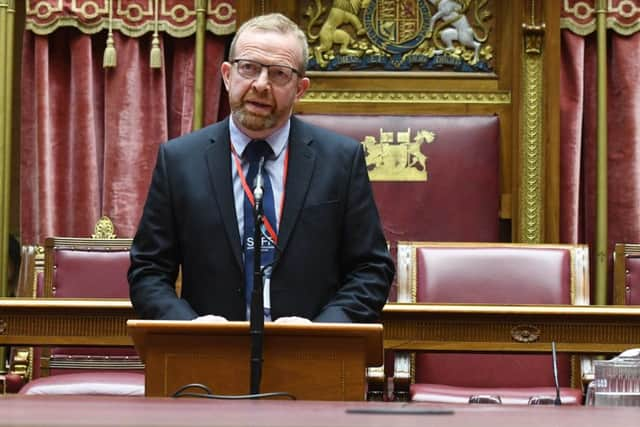Legacy Scandal: '˜Victims are alarmed at plans for past,' says brother of man murdered by IRA


It was Tuesday 13th March 1984, at approximately 7.45am, when Ronnie Funston carried out his normal morning routine.
When he headed down the lane that morning, he would have been oblivious that PIRA were lying in wait, ready to carry out their heinous act.
Advertisement
Hide AdAdvertisement
Hide AdAfter shooting him many times in the back as he sat on his tractor, our mother heard the shooting and ran to the appalling scene.


She found her middle son already dead, and saw two gunmen running up the nearby field, cheering their awful act. I was his youngest brother.
Their escape route was the same way they arrived, following a number of hedge lines and crossing the border river where it was at its lowest.
The local guide led them well, they could never have been there without help from local people. As soon as they crossed the border, they knew they had escaped, the Republic of Ireland was a safe haven.
Advertisement
Hide AdAdvertisement
Hide AdThe family had to later sell the farm and move away from the area.


The level of threat could have resulted in the family being attacked again, and our parents were too old to run the farm. But things would never be the same again for the family, in the same way as many, many other families who were attacked in this way.
The idyllic family farm running down to the sandy shores of Lough Erne had been taken from us for ever.
Why was Ronnie, murdered? This wasn’t a ‘political’ act, it was blatant sectarian murder as part of an ethnic cleansing policy of the minority unionist community conducted by the Provisional movement, combined with a local ‘land grab’.
Advertisement
Hide AdAdvertisement
Hide AdRonnie was quite simply a farmer, getting on with life, annoying no-one. The reality of it all was the Troubles was a dirty sectarian squabble, with the decent people caught in the middle.
Move the clock forward to 1998 with the Belfast Agreement, and the hope that better times were ahead for the troubled community of Northern Ireland.
Many voted, against their better judgment, to support this agreement, but ultimately they were to be badly let down.
The Blair government broke promises and made many secret deals with the Provisionals, all in the pursuit of political expediency.
Advertisement
Hide AdAdvertisement
Hide AdThe law abiding community were collateral in the British government’s pursuit of solving Northern Ireland’s issues.
The government policy of attempting to erase the past was to continue with the formation of the Historical Enquiries Team (HET) in 2005, and by the time of their demise, they had conducted reviews into almost 1,700 deaths.
Ronnie’s murder was one of the last reviews to be completed in 2014, and despite promises made by HET staff, their report was an embarrassment.
By HET’s own admission, they were not an investigative unit, they conducted desk-top reviews of retained evidence. Much of the report was generic, and to give it some extra bulk, they included family background and other personal details — the HET actually explained at length who we were as a family, to them Ronnie’s life was worth 12 pages.
Advertisement
Hide AdAdvertisement
Hide AdNow 2018, and 20 years after the Belfast Agreement, the NIO following on from the Stormont House Agreement, has proposed structures that are potentially fatally flawed and will continue to let down those who rejected terrorism.
It is almost as if the good people of the country have been abandoned by both the state and legislators, and every one else has fallen into line.
I quote Professor Frans de Waal, when he stated, “The sturdiest pillars of human morality are compassion and a sense of justice.” That sense of morality has gone, and with it the hope for justice.
“By removing those two pillars from our society, we cannot hope to produce that perfect future that we seek.
Advertisement
Hide AdAdvertisement
Hide AdWhen historians look back at the Troubles, the British cannot expect to emerge unscathed and blameless.
However, they should not be accused of being the prime movers during a period when terrorist organisations were determined to draw us all into a civil war.
Yet it is now somewhat bizarre that the British almost seem determined to consume itself from within.
The constant facilitation of the Provisionals revisionist strategy will be somewhat assisted by this draft legacy documentation, and it is difficult to understand how the NIO cannot see how this does not, in any shape or form, meet the six key principles of the Stormont House Agreement.
Advertisement
Hide AdAdvertisement
Hide AdThe consultation process has been based around four proposed legacy structures — the Historical Investigations Unit (HIU), the Independent Commission on Information Retrieval (ICIR), the Oral History Archive (OHA) and the Implementation and Reconciliation Group (IRG).
The HIU will have a director who appears will have more power than a dictator, and is answerable to no one.
Ultimately the HIU will not investigate cases unless there is new evidence, or the person responsible for the death can be identified, or an investigation could lead to disciplinary action against a person for non-criminal police misconduct.
Those who have previously had to go through the painful experience of the HET will not get a proper investigation unless the death was caused by the security forces.
Advertisement
Hide AdAdvertisement
Hide AdThe remaining cases have to meet the above criteria otherwise they will simply get a family report in the same way as the failed HET.
The ICIR seems to be an impracticable body, with loose structures that do not make any logical sense.
In real terms, the proposal is that an investigative body, the HIU, can conduct an investigation of a case alongside an non-investigative body, the ICIR.
Whilst the HIU are conducting this investigation, the ICIR are ‘politely’ asking the perpetrators of the same crime if they would like to help.
Advertisement
Hide AdAdvertisement
Hide AdFor the terrorists who do engage with the ICIR, their assistance may then be used against them by the HIU.
The OHA is to be a repository for a communal narrative, that lends to the notion once more that we were all to blame for the thirty years of terror.
A terrorist is not going to give a full narrative, warts and all, of his/her past, it will be a sanitised version.
The IRG is an institution that will ‘promote reconciliation and anti-sectarianism’, and will bring together the themes from the other three organisations.
Advertisement
Hide AdAdvertisement
Hide AdIf what has been gathered by the others is slanted, then we can only expect what will be in the resultant IRG report. Rather than promote reconciliation, this body will cause division.
Yet alongside this, the Irish government, who were co-signatories of the Anglo-Irish and Belfast Agreements, and have continual direct involvement in Northern Ireland affairs, have stated that they cannot become involved in this legislation as it comes from a “foreign” government.
They will not produce parallel legislation that leaves the Stormont House Agreement a ‘dead duck.’
This is an Irish dtate that refused to extradite terrorist suspects until the late eighties, thereby giving them a safe haven, and their state police service who were directly accused of collusion by one of their own judges in the Smithwick enquiry, but they decided to ignore it.
Advertisement
Hide AdAdvertisement
Hide AdWhat hope have the many hundreds of border families, like my family, have of ever receiving a proper investigation, when the RoI government continue to plead they are blameless.
The actuality is, as quoted by Sir Ken Bloomfield, that the Irish government acts as the advocate for the nationalist community, and this is, “the anti-thesis of that which will begin to reconcile the unionist community to the rest of Ireland”.
The question then is what is the point of this legislation, will it achieve anything?
I recall being at a conference in Queen’s University a few years ago, and a senior member of the Provisional movement stood up and stated, “I’ve done my time for Ireland, it’s time them ones did theirs.”
Advertisement
Hide AdAdvertisement
Hide AdIt’s easy to understand what some will expect to get from this legislation, and my thoughts were further confirmed when I attended a meeting in St Mary’s College.
A gentleman who would profess to be apolitical responded to a comment by saying: “The percentages you quote mean nothing. The 30% loyalist murders you talk about were all by the Brits, and we will change the 60% that you blame on republicans too.”
Therefore, we have to ask again, do the NIO proposals meet the visions of the ideologues and will once again fail the innocent victims and survivors?
I presently work as the advocacy manager of the South East Fermanagh Foundation (SEFF), and during the period of consultation, I gave a presentation at nine locations across NI, the UK and the RoI on the draft legislation.
Advertisement
Hide AdAdvertisement
Hide AdWe reached out to approximately 1,000 people, and many hundreds more have been contacting the office for assistance in completing the comprehensive and difficult to negotiate response form.
The feedback we are getting is there is almost a unified concern, anger and alarm with the proposed structures.
This legislation claims “that the approach to dealing with Northern Ireland’s past should be balanced, proportionate, transparent, fair and equitable”.
I just cannot see how this document can achieve this admirable goal in its present format.
Advertisement
Hide AdAdvertisement
Hide AdIt is extremely important that your views are captured by the NIO, and you make your response by the closing date, 10th September.
MORE ON LEGACY SCANDAL SERIES BELOW:
Advertisement
Hide AdAdvertisement
Hide AdAdvertisement
Hide AdAdvertisement
Hide Ad